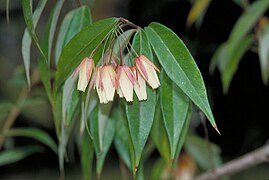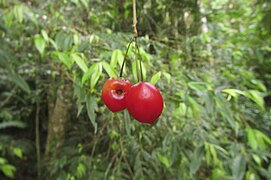| Bolly carabeen | |
|---|---|

| |
| Foliage and habit | |
| Conservation status | |
 Least Concern (IUCN 3.1) | |
| Scientific classification | |
| Kingdom: | Plantae |
| Clade: | Tracheophytes |
| Clade: | Angiosperms |
| Clade: | Eudicots |
| Clade: | Rosids |
| Order: | Oxalidales |
| Family: | Elaeocarpaceae |
| Genus: | Aceratium |
| Species: | A. megalospermum |
| Binomial name | |
| Aceratium megalospermum (F.Muell.) Balgooy | |
| Synonyms | |
| |
Aceratium megalospermum, commonly known as bolly carabeen, creek aceratium or carabeen, is a plant in the family Elaeocarpaceae found only in the Wet Tropics bioregion of Queensland, Australia.
Description
This is a small tree up to 15 m (49 ft) tall with small lanceolate to elliptic leaves arranged in opposite pairs. Flowers have five sepals and petals, and the petals are up to 17 mm (0.67 in) long by 3.5 mm (0.14 in) wide. Ripe fruit are red and contain a single seed. They measure about 18 mm (0.71 in) long and 9 mm (0.35 in) wide.
Taxonomy
The species was first described as Aristotelia megalosperma by Ferdinand von Mueller in 1875, but in 1963 it was transferred to the genus Aceratium and given its current combination by the Indonesian-born botanist Max Michael Josephus van Balgooy.
Distribution and habitat
The bolly carabeen is found only in coastal northeastern Queensland, from about Cooktown to about Tully. It grows in well developed rainforest at altitudes from sea level to about 600 m (2,000 ft). It is often found in gullies and alongside creeks.
Conservation
As of August 2024, the status of this species is assessed as least concern by the International Union for Conservation of Nature (IUCN) and under the Queensland Government's Nature Conservation Act.
Gallery
References
- ^ IUCN SSC Global Tree Specialist Group; Botanic Gardens Conservation International (BGCI) (2021). "Aceratium megalospermum". IUCN Red List of Threatened Species. 2021: e.T192497278A192497280. doi:10.2305/IUCN.UK.2021-1.RLTS.T192497278A192497280.en. Retrieved 28 August 2024.
- ^ "Aceratium megalospermum". Australian Plant Name Index (APNI). Centre for Australian National Biodiversity Research, Australian Government. Retrieved 28 August 2024.
- ^ "Aceratium megalospermum (F.Muell.) Balgooy". Plants of the World Online. Royal Botanic Gardens, Kew. 2024. Retrieved 28 August 2024.
- ^ Balgooy, M.M.J. van (1963). "Review of the Australian species of Aceratium (Elaeocarpaceae)" (PDF). Blumea. 12 (1): 74. Retrieved 28 August 2024.
- ^ F.A.Zich; B.P.M.Hyland; T.Whiffen; R.A.Kerrigan (2020). "Aceratium megalospermum". Australian Tropical Rainforest Plants Edition 8 (RFK8). Centre for Australian National Biodiversity Research (CANBR), Australian Government. Retrieved 28 August 2024.
- "Species profile—Aceratium megalospermum". Queensland Department of Environment and Science. Queensland Government. 2024. Retrieved 28 August 2024.
External links
- View a map of herbarium collections of this species at the Australasian Virtual Herbarium
- View observations of this species on iNaturalist
- View images of this species on Flickriver.com
- Biography of M. M. J. van Balgooy at the Australian National Botanic Gardens website.
| Taxon identifiers | |
|---|---|
| Aceratium megalospermum |
|
| Aristotelia megalosperma | |



